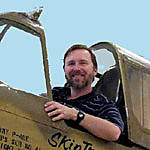
Start Here (for Beginners)
This forum is for younger modelers or people just starting out in the hobby.
This forum is for younger modelers or people just starting out in the hobby.
Hosted by Jim Starkweather
perfect assembly seams?
UNITEDSTATESNAVY

Joined: July 07, 2007
KitMaker: 243 posts
AeroScale: 150 posts

Posted: Tuesday, August 28, 2007 - 10:37 PM UTC
is it possible and/or desireable to eliminate all traces of assembly seams? I have used the tamiya putty and nail polish remover method with success on large gaps,does a quality build have visible assembly seams? 

drabslab

Joined: September 28, 2004
KitMaker: 2,186 posts
AeroScale: 1,587 posts

Posted: Wednesday, August 29, 2007 - 01:14 AM UTC
It depends.
Sometimes the model manufacturers are clever and put the seals in an area which is later covered by another part. obviously, it would be stupid to spend time on a seal which will become invisible anyway.
In other cases the seals are in places where also in the real plane there is a visible line. I have several examples of this on my bench now with the weaponry of the revell Rafale and eurofighter.
So, I first check with pictures of the real thing (there are enough sources on the internet, e.g. Prime Portal gives many walk arounds).
In case that the seal is not present in the real plane then I tend to do what is needed to remove it.
But be carefull, sometimes one can do more dammage than good.
If i have to remove a seal in an area with recessed panel lines then I tend to make these lines deeper BEFORE working on the seal. This is a lot easier than later rescribing a panel line that completely dissapeared by sanding.
Also, I cover the area around the seal with tape before starting sanding. this avoids scratches and dammage to the whole surface.
Sometimes the model manufacturers are clever and put the seals in an area which is later covered by another part. obviously, it would be stupid to spend time on a seal which will become invisible anyway.
In other cases the seals are in places where also in the real plane there is a visible line. I have several examples of this on my bench now with the weaponry of the revell Rafale and eurofighter.
So, I first check with pictures of the real thing (there are enough sources on the internet, e.g. Prime Portal gives many walk arounds).
In case that the seal is not present in the real plane then I tend to do what is needed to remove it.
But be carefull, sometimes one can do more dammage than good.
If i have to remove a seal in an area with recessed panel lines then I tend to make these lines deeper BEFORE working on the seal. This is a lot easier than later rescribing a panel line that completely dissapeared by sanding.
Also, I cover the area around the seal with tape before starting sanding. this avoids scratches and dammage to the whole surface.
Posted: Wednesday, August 29, 2007 - 01:18 AM UTC
Quoted Text
If i have to remove a seal in an area with recessed panel lines then I tend to make these lines deeper BEFORE working on the seal. This is a lot easier than later rescribing a panel line that completely dissapeared by sanding.
What a class tip. Thank you very much
Andy
Posted: Wednesday, August 29, 2007 - 10:42 AM UTC
Hmmm! Good idea Drabslab. I'll need to try that one. 

CrewChief16

Joined: July 09, 2008
KitMaker: 28 posts
AeroScale: 27 posts

Posted: Saturday, July 26, 2008 - 01:12 AM UTC


 thats brilliant,thanks!
thats brilliant,thanks!
Belt_Fed

Joined: February 02, 2008
KitMaker: 1,388 posts
AeroScale: 42 posts

Posted: Sunday, September 14, 2008 - 07:31 AM UTC
couldnt you just put tape over the panel lines and sand with the tape covering the lines? wouldnt that work?
Posted: Saturday, October 04, 2008 - 03:55 PM UTC
Hi Dave,
Here's a good tutorial: Reading the Seams. There is even a 1/48 DC-3 / C- 47 as an example!
No, one does NOT have to have a seamless model. Many aircraft are laced with seams. Here's a DC-3 I used to fly, and you can see by the dirt and grime where the seams are: My DC-3.
I use a variety of techiques. Right now I like the gap-filling superglue trick, but sometimes putty works better.
A technique that I created is using 5 minute epoxy. Assemble the parts, say the wing to the fuselage, or a nacelle to a wing, with epoxy, set it, and quickly wipe away with baby wipes! The lanolin in the wipes removes the excess epoxy and leaves a smooth surface without letting the ecess epoxy build up. But chyagottabekwik!

Here's a good tutorial: Reading the Seams. There is even a 1/48 DC-3 / C- 47 as an example!
No, one does NOT have to have a seamless model. Many aircraft are laced with seams. Here's a DC-3 I used to fly, and you can see by the dirt and grime where the seams are: My DC-3.
I use a variety of techiques. Right now I like the gap-filling superglue trick, but sometimes putty works better.
A technique that I created is using 5 minute epoxy. Assemble the parts, say the wing to the fuselage, or a nacelle to a wing, with epoxy, set it, and quickly wipe away with baby wipes! The lanolin in the wipes removes the excess epoxy and leaves a smooth surface without letting the ecess epoxy build up. But chyagottabekwik!


UNITEDSTATESNAVY

Joined: July 07, 2007
KitMaker: 243 posts
AeroScale: 150 posts

Posted: Wednesday, October 08, 2008 - 06:16 PM UTC
Quoted Text
thanks for the info very much appreciated! this type of detailed info is what I am looking for, original post I was confused as to what I wanted to eliminate in regards to what seams where present on the original plane as opposed to the downscaled replica model....I admire your quest for authenticity Hi Dave,
Here's a good tutorial: Reading the Seams. There is even a 1/48 DC-3 / C- 47 as an example!
No, one does NOT have to have a seamless model. Many aircraft are laced with seams. Here's a DC-3 I used to fly, and you can see by the dirt and grime where the seams are: My DC-3.
I use a variety of techiques. Right now I like the gap-filling superglue trick, but sometimes putty works better.
A technique that I created is using 5 minute epoxy. Assemble the parts, say the wing to the fuselage, or a nacelle to a wing, with epoxy, set it, and quickly wipe away with baby wipes! The lanolin in the wipes removes the excess epoxy and leaves a smooth surface without letting the ecess epoxy build up. But chyagottabekwik!

 will try your technique, this is a great hobby and a salute to the armed forces
will try your technique, this is a great hobby and a salute to the armed forces 
Red4

Joined: April 01, 2002
KitMaker: 4,287 posts
AeroScale: 1,164 posts

Posted: Monday, November 24, 2008 - 03:06 PM UTC
Quoted Text
No, one does NOT have to have a seamless model. Many aircraft are laced with seams. Here's a DC-3 I used to fly, and you can see by the dirt and grime where the seams are: My DC-3.
Panel lines are one thing. Assembly seams another. You don't want seams where they shouldn't be. The leading edge of a wing for example, the belly of a fuselage etc. Every plane is different, so it pays to check your references. Gerald Voigts reading the seams article is about the best and easiest I've seen in a long while. I refered to it quite a bit while working on my current build, Williams Bros. C-46....a seam filling adventure if ever there was one. "Q"

 |

















